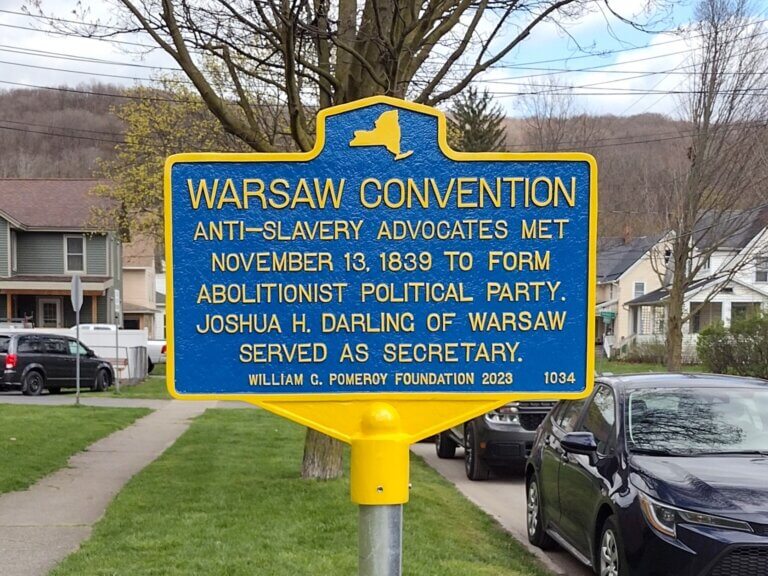WARSAW CONVENTION
- Program
- Subject
- Location
- Lat/Long
- Grant Recipient
-
NYS Historic
-
Event, People
- 52 S Main St, Warsaw, NY 14569, USA
- 42.739443, -78.132362
-
Warsaw Historical Society and The Gates House Museum
WARSAW CONVENTION
Inscription
WARSAW CONVENTIONANTI-SLAVERY ADVOCATES MET
NOVEMBER 13, 1839 TO FORM
ABOLITIONIST POLITICAL PARTY.
JOSHUA H. DARLING OF WARSAW
SERVED AS SECRETARY.
WILLIAM G. POMEROY FOUNDATION 2023
On November 13, 1839, anti-slavery advocates from western New York state met in the Presbyterian meeting house located on the corner of Main and Livingston Streets in Warsaw, New York. Josiah Andrews served as president of the convention and Myron Holley and Gideon Johnson as vice presidents of the convention. Warsaw local Joshua H. Darling served as secretary to the convention. Darling was a staunch abolitionist, who was described in his obituary published in the Western New Yorker as holding a “righteous hatred of slavery, oppression, and intemperance.” The minutes of the 1839 Warsaw convention published in the November 27, 1839 issue of the Rochester Freeman included the following resolution passed by the convention:
“That in our judgement, every consideration of duty and expediency which ought to control the action of Christian Freemen, requires of the abolitionists of the United States to organize a distinct and independent political party, embracing all the necessary means for nominating candidates for office, and sustaining them by public suffrage.”
The convention then formed a committee to pursue suitable candidates for their presidential and vice-presidential nominations. The committee was made up of Holley, Darling, and W.J. Chapin. They put forth James G. Birney of New York as their candidate for president, and Francis J. LeMoyne of Pennsylvania for their vice-presidential candidate. According to the May 1, 1840 edition of anti-slavery newspaper The Liberator, both men declined the nomination.
While not successful, the 1839 Warsaw convention was a precursor to the formation of the Liberty Party, which formed the following year at an anti-slavery convention in New York, with Birney as the presidential candidate and Thomas Earle as the candidate for vice president. The Liberty Party was a short-lived third party, with many members eventually joining the Free Soil Party and the Republican Party upon its 1854 formation. However, the Liberty Party is noted in contemporary newspapers as holding nominating conventions through at least 1860 (“New York Liberty Party,” Anti-Slavery Bugle, September 29, 1855, 3; “Liberty Party Nominations,” Douglass’ Monthly, October 1860, 339-40).

